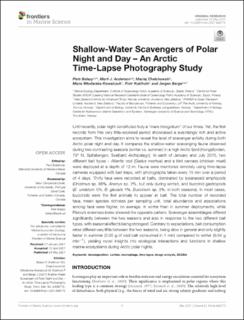| dc.description.abstract | Until recently, polar night constituted truly a “mare incognitum” of our times. Yet, the first records from this very little-explored period showcased a surprisingly rich and active ecosystem. This investigation aims to reveal the level of scavenger activity during both Arctic polar night and day. It compares the shallow-water scavenging fauna observed during two contrasting seasons (winter vs. summer) in a high Arctic fjord (Kongsfjorden, 79° N, Spitsbergen, Svalbard Archipelago). In each of January and July 2015, two different bait types – Atlantic cod (Gadus morhua) and a bird carcass (chicken meat) were deployed at a depth of 12 m. Fauna were monitored remotely using time-lapse cameras equipped with bait traps, with photographs taken every 15 min over a period of 4 days. Thirty taxa were recorded at baits, dominated by lysianassid amphipods (Onisimus sp. 88%, Anonyx sp. 2%, but only during winter), and buccinid gastropods (B. undatum 5%, B. glaciale 1%, Buccinum sp. 3%, in both seasons). In most cases, buccinids were the first animals to appear at bait. The total number of recorded taxa, mean species richness per sampling unit, total abundance and associations among taxa were higher, on average, in winter than in summer deployments, while Pielou’s evenness index showed the opposite pattern. Scavenger assemblages differed significantly between the two seasons and also in response to the two different bait types, with seasonal effects being strongest. Contrary to expectations, bait consumption rates differed very little between the two seasons, being slow in general and only slightly faster in summer (0.05 g of cod bait consumed in 1 min) compared to winter (0.04 g min–1), yielding novel insights into ecological interactions and functions in shallow marine ecosystems during Arctic polar nights. | en_US |

